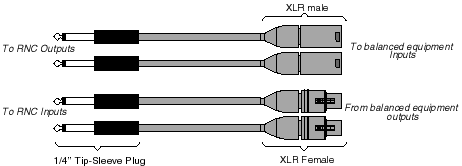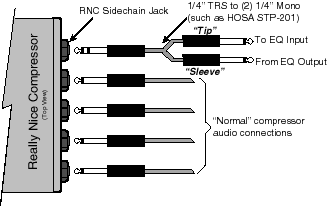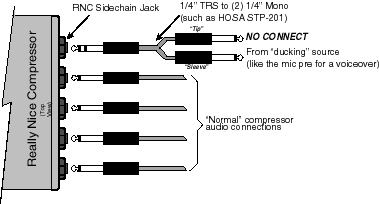Frequently Asked Questions
Here's a collection of frequently asked questions regarding the RNC, RNLA, and some general compressor tips.
1. I hate wall-warts, why does the RNC have a wall-wart?
2. Why is the RNC unbalanced instead of balanced?
3. Can the RNC be rack mounted?
4. Why does the RNC distort my bass guitar?
6. Is the RNC a peak, average or RMS-sensing compressor?
7. Does the RNC have hard-knee or soft-knee compression?
8. What cable/connector types should I use to hook up the RNC?
9. Can I use the RNC for my stereo mix bus?
10. What's the RNC's sidechain function for?
11. How do I use the sidechain function on the RNC?
I hate wall-warts, why does the RNC have a wall-wart?
First, let me assure you that, as users, we have no love of wall-warts either! There are, however, some reasons for using them with the RNC: 1) Reduce hum/noise interference between the RNC's audio circuits and an internal power supply (it's a very small package), 2) Improve the universality of the RNC for an international market (the only thing that's different between the RNC U.S. and RNC Australian is the wall-wart; no internal changes are necessary), 3) Simplifying/circumventing governmental approval of the RNC's power supply by using an already approved power supply and, 4) There's little room inside the small cabinet (used to keep the costs down) for a transformer of adequate margins.
Why is the RNC unbalanced instead of balanced?
You'd think the answer to this one would be a simple "to keep costs down". Although that's one of the reasons, there's another reason that's less obvious and the primary one: we designed the RNC to be used in home studios (like ours) made up primarily of unbalanced pieces. So, we designed it to easily interface to equipment usually found in the intended environment. For example, many home studios use mixing boards that have single Tip-Ring-Sleeve insert points on their input channels. We thought that it'd be neat, convenient and show unambiguous support for this studio type by allowing the RNC to be hooked directly to these inserts with single TRS cables. If the I/Os were balanced, we wouldn't be able to do that.
Can the RNC be rack mounted?
Yes! For rack mounting, the RNC has a #10-32 nut in its base that can be used in conjunction with a universal rack tray to mount the RNC (up to 3 on one tray) in a standard 19" rack. For applications where you want to just set it on something (if you've got the available surface area...ours are always covered with notes, cassettes, DATs, pencils, sheet music, patch cords, etc), we've included nice little non-marring rubber feet.
Why does the RNC distort my bass guitar?
At the risk of sounding too esoteric and philosophical, there are many universal laws that are, many times, inconvenient (like, say, gravity). Well, there's a mutual (and universal) exclusivity between low frequency fidelity and fast compressor release times. Stated another way: the faster a compressor's release time, the more distorted the lower frequencies will be. "Okay, okay!", you say, "I know that! But why don't I have similar problems with my other compressors?" Simply put, the RNC's normal mode release times are shorter than many compressors (some of the fastest that we've seen). This means that the RNC will induce low frequency distortion more frequently than your other compressors. "Why didn't you make the RNC so it wouldn't distort my bass notes?" Because then we'd limit (no pun intended) your creative choices for other sound sources where a really fast release time would sound really gonzo...like on kick or snare drums. Try compressing a snare drum track with the RNC set for really fast attack and release times. You'll hear drum resonances that you've never heard before that can be creatively used to add spice to your mixes!
"How do I avoid or reduce the low frequency distortion?" This one's easy: increase the release time until the distortion goes away. (Doing my best Groucho Marx impression: "Does it distort when you do that? Well don't do that!")
On some sound sources, the RNC really "pumps and breathes". What can I do to reduce the pumping and breathing?
There are several things you can do:
• Switch into SuperNice mode
• Reduce the total gain reduction amount
• Decrease the compression ratio
• Increase the attack time
• Increase the release time
The simplest of the bunch is to just switch into SuperNice mode. The other solutions will vary depending upon each other. In general, you'll want to experiment to see which of the parameter changes gives you the effect (or lack thereof) that you want. Some of the pros that we talk to tend to keep the total gain reduction to 6dB and under (sometimes only 2dB!). They also tend to not use the other parameters in extreme settings (for example, one of our pro users who uses the RNC on acoustic guitars, swears by a RATIO of less than 2:1 and gain reduction amounts less than 2dB).
Is the RNC a peak, average or RMS-sensing compressor?
Yes! Actually, the RNC uses aspects of all three depending upon the mode. In the NORMAL mode, the RNC is a peak responding compressor only. Peak-responding compressors tend to have the most extreme characteristics. We wanted to give you the ability, within one compressor, to choose between really colorful compression if you wanted it - so the peak detection for this mode was our first choice for NORMAL mode - as well as smooth, neutral-sounding compression (i.e., SuperNice mode). For the smooth part - the SuperNice mode - the RNC utilizes parts of all three detection schemes. The details of this are very nerdish and boring, but suffice to say that the SuperNice mode gives you the smoothness of an RMS and average-responding compressors (some say even more smoothness) in tandem with the signal control of a peak-responding compressor.
Does the RNC have hard-knee or soft-knee compression?
In both the Normal and SuperNice modes, the RNC is mostly a hard-knee compressor with just a touch of "softness" around the threshold point. BUT, this "softness" is very confined and predictable, so that if you're using the RNC in Normal mode, it responds more like a hard-knee compressor. Even though this same level of softness/hardness is used in the SuperNice mode's detector, there's enough other stuff going on to keep the SuperNice mode sounding very gentle (like seeing fluffy little white clouds on a sunny day while eating marshmallows... um... sorry...)
What cable/connector types should I use to hook up the RNC?
There are three initial questions:
1. Am I hooking the RNC up to an unbalanced piece of gear?
2. Am I hooking the RNC up to a balanced piece of gear?
3. Am I hooking the RNC up to special connections, like Mackie channel inserts?
Once you know the answer to these questions, you can plan the type/quantity of connectors that you'll need. However, one thing is for sure: you'll be hooking into the RNC with either a standard 1/4" phone jack (Tip-Sleeve, or TS) or a 1/4" stereo phone jack (Tip-Ring-Sleeve, or TRS). The other end of the cable will be determined by the piece of gear that you're hooking the RNC to and it's (the other gear) connector/electrical interface requirements. If you're hooking up the RNC inputs to a balanced source, we strongly recommend that you get the source equipment manufacturer's to advice you on the best way to do this. There are some output circuit and hook-up combinations that could damage your source equipment if you're not careful.
Connecting the RNC to unbalanced equipment
This connection configuration is the most straight-ahead.

Connecting the RNC to balanced (XLR) equipment
Here are the cable connections necessary to hook up the RNC to balanced equipment that uses XLR connectors.

For most of the balanced equipment you'll use, these cables are wired like this:

There are several off-the-shelf cables that can be bought already configured this way (Example: HOSA PXM-105 and HOSA PXF-105). Check with your local dealer about their recommended choices for these cables.
By the way, this all assumes that your equipment can tolerate connecting the COLD (Pin #3) to ground (some can't). So, to be on the safe side, please check with the manufacturer to make sure that you can hook up your balanced outputs this way.
Connecting the RNC to TRS Console Inserts
A unique aspect to the RNC's wiring is that it will connect to some console inserts — connecting both a single channel's input and output — with a single TRS cable:
Can I use the RNC for my stereo mix bus?
Yes. In fact, the RNC's SuperNice mode was designed for and tested extensively with stereo program material. One of our goals was to have a 2-mix compressor that sounded good, gave some signal control and didn't cost gobs of money. So, how should you hook it up to your mix bus? Probably the best way is by hooking it into your console's stereo bus inserts. BUT, you could always take the simplest approach and just take the output of the mixer, connect it to the RNC's inputs and then connect the RNC's outputs to your monitoring system. Just follow some of the guidelines we've given you above (and follow hook-up instructions of the equipment you're hooking the RNC to).
What's the RNC's sidechain function for?
There are a few additional effects/functions that compressors can provide. De-essing and ducking are two that immediately spring to mind. Both of the these functions require access to particular parts of a compressor's innards so they may be connected to some other pieces of gear to provide the desired function. For example, in order to de-ess, the RNC's detector (also referred to as the "sidechain") is connected to an equalizer. By having an equalizer in the detector, we can tell the RNC which frequencies we want it to compress more than others. Thus, for de-essing, we would accentuate (via the EQ's settings) the frequencies associated with sibilance (anywhere from 5kHz to 12kHz) while de-emphasizing all other frequencies. This would cause the RNC to compress mostly the sibilant signals and leaving the other parts of the signal mostly uncompressed.
The RNC's sidechain access may also let the RNC "duck" two signals. What's "ducking"? It's the volume reduction of music in the presence of another signal (usually a vocal narration). By connecting the voice-over signal to the sidechain (with the main/music channel hooked up to the RNC normally) and adjusting the RNC's front panel controls properly, the music will be "potted down" (i.e., reduced in volume) when the narrator is speaking.
How do I use the sidechain function on the RNC?
De-Essing with the RNC
Using the sidechain function is merely a matter of connecting the appropriate device via the appropriate adapter to the sidechain connector. For example, to use the RNC as a stereo de-esser, you would connect the RNC up as shown below.

In this application, a TRS 1/4" to (2) 1/4" mono phone plug adapter is used to get the RNC's sidechain signal out of the RNC sidechain jack to an external equalizer and back from the equalizer into the RNC. Once we insert a plug into the sidechain jack, the sidechain signal is interrupted and, if we want the RNC to do anything, we must return the signal back into the sidechain jack. The output of the sidechain is sent on the "TIP" of the sidechain connector while the returned signal is connected via the "RING" part of the connector.
"Ducking" with the RNC
This application is similar to de-essing except that we're only concerned with getting the signal we wish to "duck" with (we'll call this the "duckor" and the signal we turning down, the "duckee") into the sidechain (so that it will control the gain of the VCA). In this case, we don't care if there's a sidechain signal coming out of the RNC's sidechain jack (see below).


©2025 FMR Audio